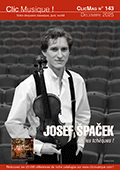 Pancho Vladiguerov serait-il l’arbre qui cache la forêt des compositeurs bulgares ? La somme assemblée avec panache par Vesko Stambolov n’en convaincant qu’en partie. L’œuvre pianistique de Lyubomir Pipkov, gravé ici dans son intégralité, n’atteint que rarement à la maitrise d’écriture, au brio et simplement au degré d’inspiration qui rend l’univers Vladiguerov si addictif, jugement sévère qui ne doit pas minorer les cahiers pédagogiques – ils sont nombreux -, où le compositeur infuse autant de poésie que de sens pratique. Le Concerto pour piano est parfois formidable – le final éruptif- et tire parfois à la ligne : l’Adagio rame ! En dehors des « ludus rithmicus », titre générique de l’album qui insiste sur un seul des visages de cet art, il faudra s’attarder sur les opus de jeunesse où l’invention est encore reine, et l’inspiration intimement mariée aux idiomes populaires : la Suite bulgare (op. 2) ne serait-elle pas son chef d’œuvre, à l’égal des splendides Variations de 1926 ? L’avant-guerre lui allait bien, il était encore dans le souvenir de ses années parisiennes passées sous le magister de Nadia Boulanger et dans l’amitié d’Yvonne Lefébure, l’après-guerre moins, comme si la rétractation des libertés artistiques avait ossifié son imaginaire qui ne rayonnera plus vraiment qu’au long des cahiers didactiques ou plus tardivement dans cette belle coda que représente l’op. 78. De ce parcours incertain, Vesko Stambolov se fait le chantre attentif et inspiré, clavier ample, couleurs à foison, profondeur des harmonies, tout y est. Demain, qui se penchera sur les œuvres de Petko Staynov, l’autre petit génie de la musique bulgare…. (Discophilia - Artalinna.com) (Jean-Charles Hoffelé)  The Bulgarian National School of Composers was one of the last ones to join the European musical family at the end of the 19th century. This significant delay had its historical reasons. Founded in 681, Bulgaria had its Golden Age in the 9th and 10th centuries. In 1396, the country fell under the Ottoman Empire and for the following almost five centuries it was virtually isolated from Europe, missing many important stages of social and cultural development. The so-called Bulgarian Renaissance, a process of national, political, and cultural revival, started at the end of the 18th century and went in accelerando towards the liberation and the reestablishment of statehood in 1878. In the following 66 years, Bulgaria underwent enormous economic and cultural upgrowth until this process was again abruptly interrupted by the Soviet occupation and the communist coup d’état in 1944. It was during this period that Bulgarian professional music won its place in Europe. [..] Born in the family of composer Panayot Pípkov, Lyubomír Pípkov (1904–1974) was not a child prodigy. From 1919 he studied piano under Ivan Torchanov and Heinrich Wiesner, and theory with Dobri Hristov in the Sófia Music School. His first attempts in composition impressed his teachers and he received, not without the help of Alfred Cortot, a modest scholarship from the French government to study in Paris. In 1926, Pípkov enrolled in the composition class of Paul Dukas at École Normale de Musique, where he also became a piano student of Yvonne Lefébure. The first compositions he showed Dukas were the 22 Variations (1926) and the Children’s Album Op. 1 (1924–26) for piano. Unlike the Children’s Album, three graceful small pieces without specific national flavour, which Pípkov deemed worthy of being given his first opus number, the romantic 22 Variations were never considered an autonomous artistic creation by the author. Instead, he treated the work as a composition exercise to explore the techniques of classical and romantic variations. We can trace the influences of Beethoven, Chopin, Schumann, even Scriabin, on young Pípkov. [..] In the late 1960’s Pípkov embarked on an ambitious project under the working title Ludus Rithmicus (an obvious allusion to Hindemith’s Ludus Tonalis) which turned out to be Pípkov’s most original contribution to European music. He created four large-scale collections of metro-rhythmic piano pieces with different level of difficulty: Metro-Rhythmic Pictures and Studies Opp. 69 & 77 (1971) and Springtime Whimsies Op. 78 (1972), both for concert pianists, From 1 to 15 Op. 81 (1973) for young pianists, and Children’s Joys for children (1974. Pípkov managed to finish only 14 of the 23 planned pieces before he died. [..] Pípkov completed this task with utmost inspiration, ingenuity, and artistry. At the same time, these pieces don’t only represent a panorama and recapitulation of Pípkov’s own imagery, development of style, genres, and language. In a way, they are also a compendium of the evolution of the Bulgarian National Style from its dawn to 1974. [..]
 |
